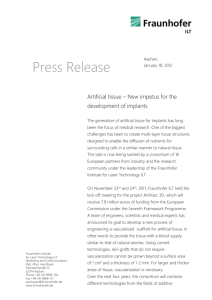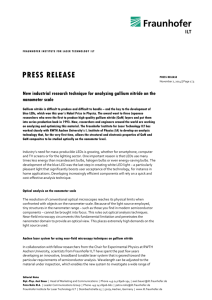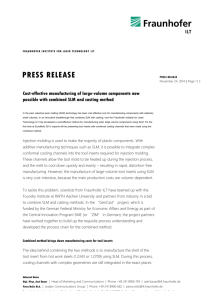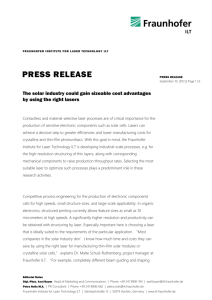DOCX 0.14 MB - Fraunhofer ILT - Fraunhofer
advertisement
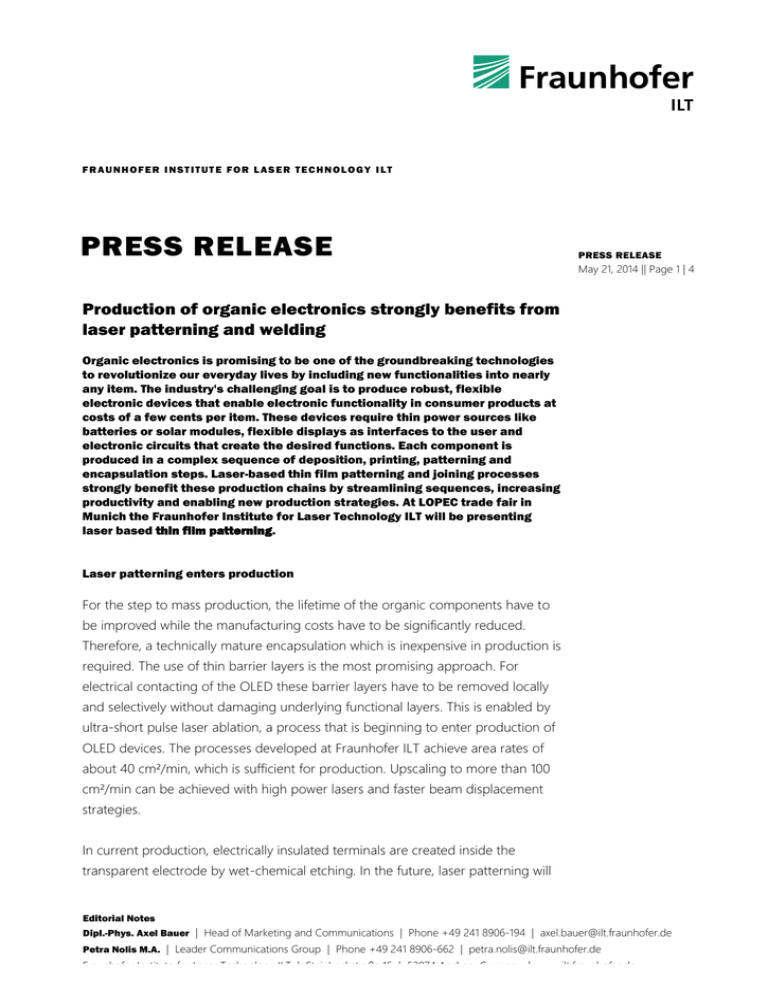
F R A U N H OF E R I N S T I T U T E F O R L A S E R T E C H N O L O G Y I L T PRESS RELEASE PRESS RELEASE May 21, 2014 || Page 1 | 4 Production of organic electronics strongly benefits from laser patterning and welding Organic electronics is promising to be one of the groundbreaking technologies to revolutionize our everyday lives by including new functionalities into nearly any item. The industry's challenging goal is to produce robust, flexible electronic devices that enable electronic functionality in consumer products at costs of a few cents per item. These devices require thin power sources like batteries or solar modules, flexible displays as interfaces to the user and electronic circuits that create the desired functions. Each component is produced in a complex sequence of deposition, printing, patterning and encapsulation steps. Laser-based thin film patterning and joining processes strongly benefit these production chains by streamlining sequences, increasing productivity and enabling new production strategies. At LOPEC trade fair in Munich the Fraunhofer Institute for Laser Technology ILT will be presenting laser based thin film patterning. Laser patterning enters production For the step to mass production, the lifetime of the organic components have to be improved while the manufacturing costs have to be significantly reduced. Therefore, a technically mature encapsulation which is inexpensive in production is required. The use of thin barrier layers is the most promising approach. For electrical contacting of the OLED these barrier layers have to be removed locally and selectively without damaging underlying functional layers. This is enabled by ultra-short pulse laser ablation, a process that is beginning to enter production of OLED devices. The processes developed at Fraunhofer ILT achieve area rates of about 40 cm²/min, which is sufficient for production. Upscaling to more than 100 cm²/min can be achieved with high power lasers and faster beam displacement strategies. In current production, electrically insulated terminals are created inside the transparent electrode by wet-chemical etching. In the future, laser patterning will Editorial Notes Dipl.-Phys. Axel Bauer | Head of Marketing and Communications | Phone +49 241 8906-194 | axel.bauer@ilt.fraunhofer.de Petra Nolis M.A. | Leader Communications Group | Phone +49 241 8906-662 | petra.nolis@ilt.fraunhofer.de Fraunhofer Institute for Laser Technology ILT | Steinbachstraße 15 | 52074 Aachen, Germany | www.ilt.fraunhofer.de Steinbachstraße 15 | 52074 Aachen, Germany | www.ilt.fraunhofer.de F R A U N H OF E R I N S T I T U T E F O R L A S E R T E C H N O L O G Y I L T replace this, since it enables less complex production sequences with smaller structure sizes and higher throughput. The new patterning process developed at Fraunhofer ILT uses ultra-short pulses to open up new process windows, enabling physical processes which are not possible with longer pulse durations. Typical problems of removal processes, like residual particles and layer delamination, can be avoided this way. Laser patterning processes always rely on the local removal of the conductive material, so called ablation. While this is often viable for production, the drawbacks of particle residue and delamination can be avoided entirely if the conductivity of the material is reduced without actually removing the material. The benefits of such an ablation-free laser patterning are currently investigated at Fraunhofer ILT in cooperation with several partners from the industry. In addition to the complete prevention of residues, laser-induced damage to neighboring material is reduced and productivity can be drastically increased due to the use of less expensive laser sources. Laser based roll-to-roll manufacturing Coming technologies like printed electronics, polymer solar cells and advanced batteries need to exploit the productivity of roll-to-roll (R2R) continuous manufacturing to reduce costs and achieve wide acceptance. By integration of laser processing complex steps like lithography, structured printing and gluing can be replaced. One application currently developed at Fraunhofer ILT aims at highly productive parallelized patterning for the series interconnection of organic solar cells. In comparison to production chains relying on patterned printing and evaporation processes, laser patterning allows the reduction of the inactive zone by three orders of magnitude. In addition, a combination with laser polymer welding for encapsulation allows a highly simplified production chain. The laserbased roll-to-roll system set up at Fraunhofer ILT in cooperation with LIMO, 4JET, PRESS RELEASE May 21, 2014 || Page 2 | 4 F R A U N H OF E R I N S T I T U T E F O R L A S E R T E C H N O L O G Y I L T Coatema and the Chair for Applied Laser Technology at the Ruhr University Bochum allows patterning and welding at area rates of up to 1 m²/min. Fraunhofer ILT at the International Exhibition for the Printed Electronics Industry LOPEC in Munich, Germany Our experts will be presenting applications for thin film patterning at the Network »COPT.NRW« booth (booth no. 208), the Center for Organic Production Technologies of the state of North Rhine-Westphalia, Germany, from May 27-28, 2014. Picture 1: Laser ablation of OLED barrier layers. Fraunhofer ILT, Aachen / Volker Lannert. PRESS RELEASE May 21, 2014 || Page 3 | 4 F R A U N H OF E R I N S T I T U T E F O R L A S E R T E C H N O L O G Y I L T Picture 2: Roll-to-roll laser patterning using multi-beam comb. Fraunhofer ILT, Aachen. PRESS RELEASE May 21, 2014 || Page 4 | 4 The Fraunhofer-Gesellschaft is the largest organization for applied research in Europe. Its research activities are conducted by 67 Fraunhofer Institutes at numerous locations throughout Germany. The Fraunhofer-Gesellschaft employs a staff of more than 23,000, who work with an annual research budget totaling 2 billion euros. Of this sum, 1.7 billion euros is generated through contract research. More than 70 percent of the Fraunhofer-Gesellschaft’s contract research revenue is derived from contracts with industry and from publicly financed research projects. Affiliated research centers and representative offices around the world provide contact with regions of greatest importance to present and future scientific progress and economic development. For further information Dr. Malte Schulz-Ruthenberg | Micro- and Nanostructuring Group | Phone +49 241 8906-604 | malte.schulzruhtenberg@ilt.fraunhofer.de Fraunhofer Institute for Laser Technology ILT, Aachen, Germany | www.ilt.fraunhofer.de Dieses Feld, sowie die Tabelle auf der letzten Seite nicht löschen!
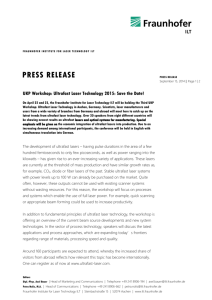
![LASHARE Press Release Project Start [ DOCX 0.29 MB ]](http://s3.studylib.net/store/data/006895368_2-c419881f96c28d1378c5ef51519b8fdb-300x300.png)
![Scalable SLM machine design [ DOCX 0.15 MB ]](http://s3.studylib.net/store/data/006980860_1-a3d8729653f9ce51e6e3d7d4cce3f10e-300x300.png)
